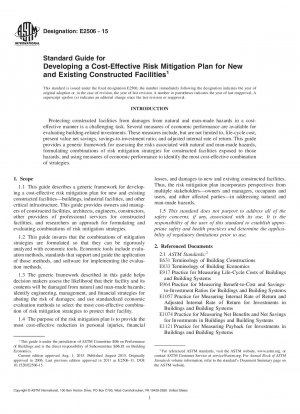ASTM E2506-15
Standard Guide for Developing a Cost-Effective Risk Mitigation Plan for New and Existing Constructed Facilities
- Standard No.
- ASTM E2506-15
- Release Date
- 2015
- Published By
- American Society for Testing and Materials (ASTM)
- Status
- Replace By
- ASTM E2506-15(2020)e1
- Latest
- ASTM E2506-15(2020)e1
- Scope
5.1 Standard practices for measuring the economic performance of investments in buildings and building systems have been published by ASTM. A computer program that produces economic measures consistent with these practices is available.5 The computer program is described in Appendix X3. Discount8201;Factor8201;Tables has been published by ASTM to facilitate computing measures of economic performance for most of the practices.
5.2 Investments in long-lived projects, such as the erection of new constructed facilities or additions and alterations to existing constructed facilities, are characterized by uncertainties regarding project life, operation and maintenance costs, revenues, and other factors that affect project economics. Since future values of these variable factors are generally unknown, it is difficult to make reliable economic evaluations.
5.3 The traditional approach to uncertainty in project investment analysis is to apply economic methods of project evaluation to best-guess estimates of project input variables, as if they were certain estimates, and then to present results in a single-value, deterministic fashion. When projects are evaluated without regard to uncertainty of inputs to the analysis, decision makers may have insufficient information to measure and evaluate the financial risk of investing in a project having a different outcome from what is expected.
5.4 To make reliable economic evaluations, treatment of uncertainty and risk is particularly important for projects affected by natural and man-made hazards that occur infrequently, but have significant consequences.
5.5 Following this guide when performing an economic evaluation assures the user that relevant economic information, including information regarding uncertain input variables, is considered for projects affected by natural and man-made hazards.
5.6 Use this guide in the project initiation and planning phases of the project delivery process. Consideration of alternative combinations of risk mitigation strategies early in the project delivery process allows both greater flexibility in addressing specific hazards and lower costs associated with their implementation.
5.7 Use this guide for economic evaluations based on Practices E917 (life-cycle costs), E964 (benefit-to-cost and savings-to-investment ratios), E1057 (internal rate of return and adjusted internal rate of return), E1074 (net benefits and net savings), E1121 (payback), E1699 (value engineering), and E1765 (analytical hierarchy process for multiattribute decision analysis).
5.8 Use this guide in conjunction with Guide E2204 to summarize the results of economic evaluations involving natural and man-made hazards.
ASTM E2506-15 Referenced Document
- ASTM E1057 Standard Practice for Measuring Internal Rate of Return and Adjusted Internal Rate of Return for Investments in Buildings and Building Systems
- ASTM E1074 Standard Practice for Measuring Net Benefits for Investments in Buildings and Building Systems
- ASTM E1121 Standard Practice for Measuring Payback for Investments in Buildings and Building Systems
- ASTM E1185 Standard Guide for Selecting Economic Methods for Evaluating Investments in Buildings and Building Systems
- ASTM E1369 Standard Guide for Selecting Techniques for Treating Uncertainty and Risk in the Economic Evaluation of Buildings and Building Systems
- ASTM E1557 Standard Classification for Building Elements and Related Sitework-UNIFORMAT II
- ASTM E1699 Standard Practice for Performing Value Engineering (VE)/Value Analysis (VA) of Projects, Products and Processes
- ASTM E1765 Standard Practice for Applying Analytical Hierarchy Process (AHP) to Multiattribute Decision Analysis of Investments Related to Buildings and Building Systems
- ASTM E1946 Standard Practice for Measuring Cost Risk of Buildings and Building Systems
- ASTM E2103/E2103M Standard Classification for Bridge Elements—UNIFORMAT II
- ASTM E2166 Standard Practice for Organizing and Managing Building Data
- ASTM E2204 Standard Guide for Summarizing the Economic Impacts of Building-Related Projects
- ASTM E631 Standard Terminology of Building Constructions
- ASTM E833 Standard Terminology of Building Economics*, 2024-04-20 Update
- ASTM E917 Standard Practice for Measuring Life-Cycle Costs of Buildings and Building Systems
- ASTM E964 Standard Practice for Measuring Benefit-to-Cost and Savings-to-Investment Ratios for Buildings and Building Systems
ASTM E2506-15 history
- 2020 ASTM E2506-15(2020)e1 Standard Guide for Developing a Cost-Effective Risk Mitigation Plan for New and Existing Constructed Facilities
- 2015 ASTM E2506-15 Standard Guide for Developing a Cost-Effective Risk Mitigation Plan for New and Existing Constructed Facilities
- 2011 ASTM E2506-11 Standard Guide for Developing a Cost-Effective Risk Mitigation Plan for New and Existing Constructed Facilities
- 2006 ASTM E2506-06e1 Standard Guide for Developing a Cost-Effective Risk Mitigation Plan for New and Existing Constructed Facilities
- 2006 ASTM E2506-06 Standard Guide for Developing a Cost-Effective Risk Mitigation Plan for New and Existing Constructed Facilities

Copyright ©2024 All Rights Reserved